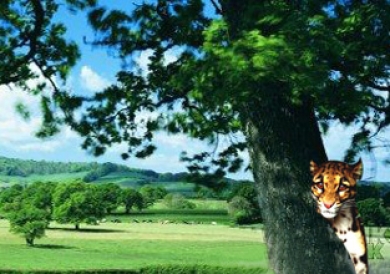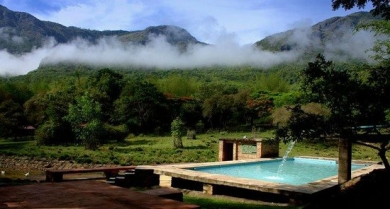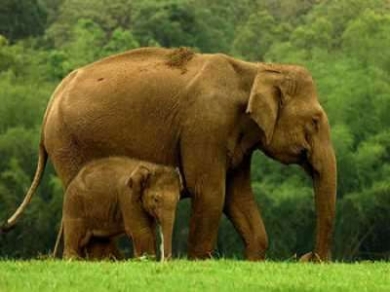Masinagudi is a nature getaway located on Mysore-Ooty highway right next to Mudumalai Wildlife sanctuary.It is a hilly terrain Western Ghats, clothed in dense mixed and moist deciduous forests and located just on the border of Karnataka and Tamilnadu (Other side of the border being Bandipur National Park).Masinagudi is renowned for off-beat getaways offering nature centric stays.Masinagudi (Mudumalai) is 32 kms from Ooty. This area of the Nilgiris is home to over 320 species of birds, both migratory as well as resident. Regional endemics include Malabar trogon and Malabar grey hornbill. Predatory birds include the crested hawk-eagle and the crested serpent eagle. It also holds an isolated southern population of the Striped Tit-babbler. Masinagudi is one of the highly preferred holiday destinations in Southern India because of its exotic locales and extensive wildlife presence. Tourists have an exciting range of options to see in and around Masinagudi for a wholesome experience.
Some important questions arise when we choose a destination.
Most important places to Visit in Masinagudi. / Sightseeing places in Masinagudi
Which all places I can visit along with Masinagudi?
Tour Itineraries along with Masinagudi
Best time to visit Masinagudi
How to reach Masinagudi?
Most important places to visit in Masinagudi. /Sightseeing places in Masinagudi
The National Park organizes van safaris into unspoilt sanctuary areas, either from 6:30 – 8.30 a.m. or 3 to 6 p.m. The ride usually lasts anywhere between 45 minutes to an hour and spotting game is pretty common. These trips are perfect for wildlife buffs who wish to spot the spotted deer, bear with a bear, or even see something as boaring as a boar. Alternatively, you could tour the jungle Mowgli style, atop a tame elephant! Four people and a trained mahout will be carried by our resident gentle giant into the jungle, away from the beaten track, along the road not taken. Because the elephant actually goes through the jungle, chances of seeing game at close quarters are pretty good.
Elephant Camp:
Visit forest department elephant camp where around 29 pachyderms are cared for and trained. You can witness them give a thorough cleaning, followed by a pooja (offering to the deity) by the elephants themselves and culminating in feeding them. Believe it or not, each have their own diet on an everyday basis to adhere to. But beware, lest you get taken for a ride!
Visit To:
Like the famous Darjeeling tea, the Nilgiri Tea plantations are famous for its green leaf tea. A visit to a local tea, coffee or pepper plantation as a half day or full day trip could be organized. The trip gets all the more exciting and refreshing when one actually gets to visit a factory and observe the journey of the leaf through different processes before its end.
OOTY:
A day trip to Ooty, one of the many hill stations explored and discovered by the British can also fit into the agenda. It includes a visit to the renowned botanical gardens, boating on the lake, toda museum, etc Do some shopping for silver jewellery and don’t forget to leave Ooty without a bag of home made chocolates, some eucalyptus and citronella oils.
GOPALSWAMI BETTA:
Many of our guests enjoy a full day excursion (with packed lunch) through the twin sanctuaries of Bandipur and Mudumalai, to Gopalswami Betta, a hill with a historic temple at its peak. Being part of the Project Tiger Reserve, one could look down on the plateau as tiger sightings have been getting increasingly more common than rare.
GAURIBARA:
In the foothills of the Nilgiris adjoining Mudumalai wildlife sanctuary at the base of the mountain called Gauri Bara nestles this huge piece of privacy. ‘Gauri Bara' means `Honey Cleft' in to the Sholegas, and Golden Rock Face' to the Kasabas. The location is a five and a half hour drive from Bangalore on the Mysore- Ooty road. It is a coffee Estate started in about 1869, coffee is still grown on the Estate, you can still see the snow-white blossom in March, and the Holly red berries in November / December. You can also see the ancient temples and alters built and still used by the local Kurumba, Irula and Toda tribals. This is also the area where Kenneth Anderson hunted Man-eaters. Though there are no Man-eaters now, if you are very lucky and happen to be in the right place at the right time you may get to see a tiger. The forest in and around the estate has a lot of Elephants, which are kept out of the Campsites by a solar powered fence. Other wise the place has its resident wildlife like leopard, bear, deer, bison, langurs, monkeys, malabar squirrel, Hyena, wild dogs, hare, and many more. It is also a bird watchers paradise and an Entomologist's haven. The location is situated on the leeward side of the Nilgiris at an altitude of 950 meters msl, in a natural scrub forest, with temperatures varying between 20 o C and 35 o C.
KALLIKUDAR:
This place was one of the oldest rubber estates in the country. Now tea, pepper and spices are grown here on a very small area and the rest of the estate has been converted into a private wildlife reserve allowing the natural vegetation to regenerate. It is on the Mettupalayam-Kotagiri ghat Road, only 90 minutes from Coimbatore and 6½ hours from Bangalore. Here you can see and experience the Nilgiris as it was intended to be by nature. The place is endowed with beautiful natural features like mountains, valleys, gorges, rocks, rock faces, caves, streams, waterfalls, meadows,swamps, forests etc. Animals like Elephants, Gaur, bear and leopard make theirs homes in the jungles here. Irula tribals live and work on the plantation. The weather is pleasant all round the year and the locale green. Situated on the windward side of the Nilgiris at an altitude of about 1000 meters msl, amid lush forests the temperatures vary between 15 o C and 27 o C.
Bird Watching
This area of the Nilgiris is home to over 320 species of birds, both migratory as well as sedentary. The sholas and jungles provide perfect habitat for them all year round. Wild Canopy Reserve offers bird watching treks that can last from 2 hours to 8 hours depending on what you want. These treks will be an organized guided tour that will include the guide-cum-local ornithologist who has combed this area the last 29 years and been part of special teams in the related field in many of the National Parks of India. He will assist you in spotting as well as listening to the calls of our feathered friends. If on your walk you happen to hear a naughty whistle-song, it is for sure not a schoolboy playing truant. Rather it is the melody of the Malabar Whistling Thrush which one could listen for hours.
Birds found:
Grey Headed Bulbul, White Bellied Minivet, Jorden Bush Lark , White Bellied Woodpecker, White Napped Woodpecker, Speckled Piculet, Streak Throated Wookpecker, Indian Pitta Great Pied Hornbill, Malabar Grey Hornbill, Painted Bush Quail, Nilgiri Wood Pigeon, Yellow Legged Button Quail, Alpine Swift Sri Lanka Frogmouth, Sarvanna Night Jar Jerdons Nightjar, Great Eared Nightjar Sirkeer Malkoha ,Pied Cuckoo, Drongo Cuckoo, Rufus Bellied Hawk Eagle, Black Eagle, Red Headed Vulture, Blue Face Malkoha, Malabar Crested Lark, Indian Blue Robin, Malabar Whistling Thrush, Brown Fish Owl, Eurasian Eagle Owl, White Rumped Needletail, Stork Billed Kingfisher, Blue Bearded Bee Eater White Cheeked Barbet, Asian Fairy Bluebird, Dusky Crag Martin, Wire Tailed Swallow, Crested Tree Swift, Bay Back Shrike, Puff Throated Babbler, Large Grey Babbler, Little Spider Hunter, White Rumped Shama, Olive Backed Pipit, Forest Wag Tail, Black Throated Munia, Plain Flower Pecker, Chestnut Shouldered Petronia.
Nearby Camping spots:
Wynaad Laughing Thrush, Malabar Pied Hornbill, Rufus Babbler, Blue Capped Rock Thrush. Scaly Thrush, White Bellied Shortwing, Nilgiri Black Bird, Nilgiri Laughing Thrush, Yellow Cheeked Tit, Nilgiri Pipit Grey Headed Canary Flycatcher Black And Orange Flycatcher, Verditer Flycatcher Nilgiri Flycatcher White Bellied Blue Flycatcher.
Which all places I can visit along with Masinagudi?
Tour Itineries along with Masinagudi
Coimbatore - Ooty - Masinagudi - Coimbatore
Coimbatore- Ooty- Masinagudi - Coonoor- Coimbatore
Masinagudi - Bandipur - Ooty
Bangalore - Mysore - Masinagudi - Ooty - Bangalore
Ooty – Masinagudi - Kodaikanal - Munnar - Kumarakom
Bangalore - Mysore - Masinagudi - Ooty - Coimbatore
Masinagudi - Ooty – Kodaikanal- Munnar- Cochin
Coimbatore - Ooty - Conoor – Masinagudi - Kodaikanal - Munnar - Periyar - Kumarakom - Alleppey - Cochin
Bangalore - Mysore - Nagarhole - Masinagudi - Bandipur - Ooty – Bangalore
Best time to visit Masinagudi
June To September:
The climate is invigorating, the forest lush, tender and green. Game spotting is at its peak. As we are located in a rain shadow area, we do not receive torrential rainfall. Our monsoon is characterized, rather, by short spurts of rain, strong wind and temperatures between 16o celcius to 28o celcius.
A good pair of walking shoes is a necessity. Jeans or tough trousers and a windcheater will save your hide should you should choose to walk through bush. If you prefer short walks or plan on lazing it, though, shorts and a T shirt should suffice. Oh - and don't forget your umbrella!
October To November:
In this season, you should see plenty of wild life, as the undergrowth thickens for the winter. The temperatures range from 13o C to 21o C.The mornings are misty, with the clouds sitting on the mountain ranges. The North-East Monsoon sets in and is through by the end of November.
A sweater may be required. You will definitely need an umbrella or a raincoat, and a tough pair of shoes to help you over wet ground and rocks . A couple of pairs of socks would be a good idea - and a second pair of shoes in case you decide to walk into a puddle.
December To January:
Our winter boasts clear blue skies, cool, starry nights and sunny days. Temperatures drop significantly. Mornings are generally misty.
The air is a bit nippy, and a sweater would be a good thing to have with you. We do offer the more exciting option of a bonfire on clear nights, though.
February To April:
The advent of summer is characterized by dry warmth. The deciduous forest is bare. Game is usually spotted around water holes. There are often small forest fires, which burn some of the undergrowth by day, only to be extinguished by dew at night.
Light clothing, sun glasses, hats and sunscreen would be appropriate. Again, don't forget those walking shoes and trousers!
May:
May weather is uniformly unpredictable - Pre-monsoon showers, warm days that draw in clouds, thunder bolts, short blasts of rain - and the jungle comes alive . The vegetation revives and sprouts fresh shoots The birds sing louder. All in all the flora and fauna come alive.Light clothing (think Baywatch) with sunscreen lotion (think sunburn).
How to reach Masinagudi?
How to reach Masinagudi by Air
The nearest airport to Masinagudi in Tamil Nadu is Coimbatore at a distance of 140 kms. Coimbatore Airport is 12 km from the city and is well connected with Mumbai, Chennai and Kozhikode (Calicut). One international flight to Sharjah (UAE) is also operating from here.
How to reach Masinagudi by Rail
The nearest railway station to Masinagudi is the Mysore railway station, which is at a distance of 90km. Passenger and express trains link Mysore with Bangalore, Chennai and other prominent places. The super fast Shatabdi Express connects Mysore to Chennai.
How to reach Masinagudi by Road
From Bangalore (260kms), you can take the state run buses or hire private taxis to reach Masinagudi. An alternate route from Bangalore begins from SH 17 and then shifts to NH 212 from Mysore via Najangud and then to NH 67 to Bandipur leading to Masinagudi. From Coimbatore, take SH 67 to reach Masinagudi. You can also reach Ooty (36 kms) and drive down to Masinagudi.
Packages

5 Nights Tamil Nadu - 3 Star - Rs.31800
Masinagudi Packages

3 Nights Tamil Nadu - 3 Star - Rs.29100
Masinagudi Packages

4 Nights Tamil Nadu - 3 Star - Rs.32100
Masinagudi Packages
